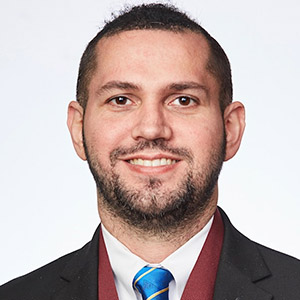
By Ricardo Correa, MD, EdD, FACP, FACE, FACMQ; Program Director of the Endocrinology, Diabetes and Metabolism Fellowship; Director for Diversity, Graduate Medical Education, UACOM-P; Associate Professor of Medicine, University of Arizona College of Medicine-Phoenix and Phoenix VAMC*

Health inequities exacerbate the impact of chronic conditions on vulnerable populations. These populations include patients who are racial and/or ethnic minorities, among others. Latinx, one of those populations, has been suffering from health care disparities throughout history in this country. For clarification, Latinx is a gender-neutral neologism that refers to people of Latin American cultural or ethnic identity living in the United States.
Per the U.S. Census Bureau, 18.3 percent of the population identify as Latino/Hispanic. Latinx communities often face more considerable stigmatization complications, affecting their physical, mental, and social health.1 The lack of economic resources, language barriers, low health literacy, lack of health acculturation strategies, poor access to health care, and fear of seeking treatment due to immigration policies2 all contribute to increased patient vulnerability.3
As an internist and endocrinologist, I decided to dedicate a significant portion of my career to helping people who need it the most. As part of that commitment, I volunteer at an underserved clinic in downtown Phoenix. I see firsthand how Latinx patients struggle to get access to health care. Phoenix Alliance Community Health is a volunteer-run clinic that primarily caters to the uninsured and undocumented Latinx population. We work with different resources to provide medical care and address all the social determinants of health impacting our patients.
Oftentimes when dealing with health care disparities, you don’t need to recreate the wheel. Multiple successful and proven programs are targeted to select patient populations that can be adapted to your specific population. As an example, we are attempting to close the gap in diabetes mellitus using the Vida Sana/Healthy Life Program at the clinic. I had the opportunity to see how this program works for the Latinx patients being treated at the Hope Clinic in Providence, Rhode Island. Although the Phoenix Latinx community is different from the one in Providence, the program has been an equally successful intervention for the Phoenix Latinx population. The Vida Sana program uses low literacy, language-appropriate materials, and trained peers to educate participants about healthy lifestyles in a setting that also provides social engagement opportunities.4
COVID-19 has exacerbated the baseline disparities that already existed. Hospitalizations and deaths due to the pandemic have disproportionately affected Latinx.5 The lack of education in a culturally and appropriate language has been particularly problematic. In response, during the past 12 months we have put a lot of effort into disseminating the correct information to the communities using various Spanish-speaking media vehicles and creating programs to train community health care workers so they can help fight against the myths and fake news. The Latinx community trusts its own members, so our Spanish-speaking physician strategy has been very successful. This model’s success gives us hope that these best practices can be implemented in communities across the entire country.
In conclusion, there are higher rates of potentially preventable complications and hospitalizations from chronic conditions among Black and Brown communities. We can use this time as an opportunity to turn the tide and improve the lives of the underserved communities. It is morally right and our ethical obligation to advance health equity among vulnerable populations, and it is equally essential that we protect the public’s health. Our nation must prioritize the health of the Latinx community and be positioned to protect vulnerable people in times of disaster to not only survive but thrive – not only today but for generations to come. My goal is to empower the Latinx community to have a voice in all health care decisions as a means to decrease disparities, and I invite others to join me in this effort. If we join forces, share our best practices, and work together we can, and will, achieve this goal.
“My goal is to empower the Latinx community to have a voice in all health care decisions as a means to decrease disparities, and I invite others to join me in this effort.”
Twitter @drricardocorrea
References
1 Lee I-K, Wang C-C, Lin M-C, Kung C-T, Lan K-C, Lee C-T. Effective strategies to prevent coronavirus disease-2019 (COVID-19) outbreak in hospital. J Hosp Infect. 2020;105(1):102-103.
2 Inadmissibility on Public Charge Grounds. In: Federal Register [Internet]. 10 Oct 2018 [cited 5 Jan 2021]. Available: https://www.federalregister.gov/documents/2018/10/10/2018-21106/inadmissibility-on-public-charge-grounds. (Accessed Jan. 30, 2021)
3 Hutchins SS, Fiscella K, Levine RS, Ompad DC, McDonald M. Protection of Racial/Ethnic Minority Populations During an Influenza Pandemic. Am J Public Health. 2009;99: S261.
4 Buckley J, Yekta S, Joseph V, et al. Vida Sana: a lifestyle intervention for uninsured, predominantly Spanish-speaking immigrants improves metabolic syndrome indicators. J Community Health. 2015;40(1):116-23.
5 CDC. COVID View, Key Updates for Week 50. Centers for Disease Control and Prevention. Published December 15, 2020. https://www.cdc.gov/coronavirus/2019-ncov/covid-data/covidview/index.html. (Accessed Jan. 30, 2021)
* Dr. Correa is a member of the ABMS Stakeholder Council and ABMS Standards Task Force.
© 2021, American Board of Medical Specialties
Read the Latest Issue of the ABMS Insights Newsletter
-
Read More:
- ABMS Insights |
- Guest Columns |
- Public Health |
